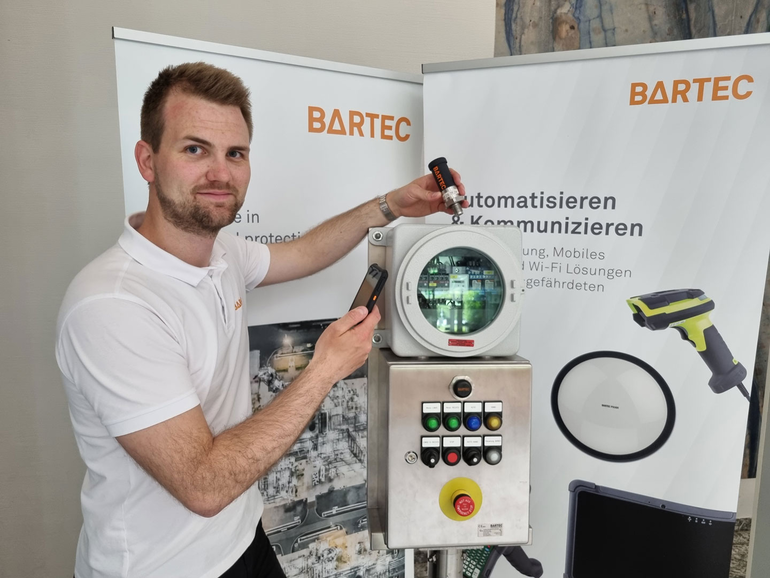Martin, digitalization is a big “buzzword” within the industry. Why is digitalization also a topic within hazardous areas?
MARTIN: Our industry has always been more conservative than traditional industrial areas. However, we have seen a significant increase in the digitalization of the process industry during the last few years: Smart phones and tablets are commonly used to do maintenance, Wi-Fi is available almost everywhere, and data is used to optimize processes and work tasks. Knowing that the hazardous areas usually follow these industry trends, we believe that the time is now to help our customers to benefit from and implement these available technologies – as a trusted partner!
What is your personal vision for digitalization for BARTEC?
MARTIN: My personal vision for the company is that we successfully manage to be at the forefront of digitalization within the hazardous areas. That is because I see a lot of growth potential based on interesting new business models in there which we will approach with our digital agenda. However, coming to these opportunities is unknown to us as these require proactive problem detection together with the end-user and new technological capabilities that are far more software-related than in hardware engineering. I am very excited and full of motivation to shape the digital leading EX company.
Janis, what is the digital agenda of BARTEC?
JANIS: Firstly, we want to expand our superior market position of providing hardware connectivity solutions for hazardous areas. Secondly, we want to extend the value of our products by both allowing collecting data and connectivity as well as offering unique digital databased add-on services. Thirdly, we would like to support our customers to make use of established digital technologies within the EX areas.
Per-Erik, you are the head of the product line “Connectivity”. What are the current trends within the sites of your customers?
PER-ERIK: A regular Wi-Fi connection has been around in the EX industry for many years already. However, the expectations from our customer of having high speed and reliable networks are now much higher. This also put pressure on us to always look for new solutions to keep up with the fast change of technology from the major access points vendors. The customers, who still uses pen and paper is looking for Wi-Fi as basic connectivity and early adopter of Wi-Fi is now starting to deploy and the implement the latest 5G technology as their next step towards a digital future.
What is our current offering and what differentiates it from other solutions on the market?
PER-ERIK: BARTEC is one of the key players within connectivity for hazardous areas. Our product range consists of enclosures and antennas for wireless networks, and IoT sensors for predictive maintenance. BARTEC has several innovative solutions such as the new EXgate360 where we as the only company on the market can offer a Zone 1 solution for devices with internal antennas. This is preferred on oil rigs where physical size and weight of the enclosure play a crucial role for the customer. Now, with Extronics on board, BARTEC has the broadest connectivity solution range on the market for all wireless technologies including Wi-Fi, LTE and 5G.
Andrej, we have talked very much about infrastructure needed to go digital in our customer sites. The products of Enterprise Mobility go a step further and allow mobile communication in the EX areas. Why is this beneficial in the EX areas and what is special about your products?
ANDREJ: The big trends driving the need for EX-certified mobile devices include shift from pen- and paper-based working to digitalization of core tasks and processes, as well as regulation that evolves to ensure safety in the workplace. The specialized know-how that is needed to build and certify EX devices takes years to build, and BARTEC is a pioneer in this market with decades of experience.
I hear you often talking about the “digital worker”. Could you briefly describe what you mean by that?
ANDREJ: Today it might be enough to just say ‘Worker’, as using devices such as mobile phones, tablets and scanners is already commonplace. For our customers, digital means fewer manual activities, faster way to achieve the tasks at hand, and a way to manage information in an effective and secure way. The use cases can vary from taking pictures in an oil platform to managing material flows in a manufacturing site. We are also seeing that companies are realizing that they need to move from regular consumer devices to EX devices in certain areas of their operations, and this means the users expect the EX devices to be similar to what they are used to in terms of function and appearance.
How does BARTEC actively address these requirements and what can we expect from your BU in the next years?
ANDREJ: Security and safety are at the heart of what we do, and we don’t cut corners in delivering against that promise. Focus needs to be firmly also on the end-user satisfaction to the products we create, from device to its accessories and lifecycle services. The digital market keeps evolving, and we keep pushing the boundaries of what the world has seen in the EX device market to earn our business and success every day. We recently announced the launch of the BARTEC SP9EX1 smartphone and BARTEC SC9EX1 smart scanner, which will be available across our target markets, starting in Q2 2024. We are thus driving forward the digitalization of hazardous areas in a way never seen before in the industry.
